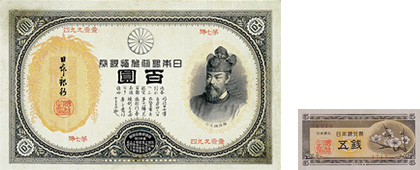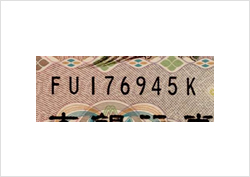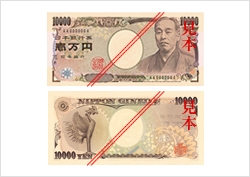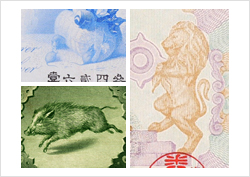Banknote Trivia
Here is some trivia about banknotes.
Largest banknote / Smallest banknote
The largest banknote ever issued in Japan is the remodeled 100-yen note, which was issued on November 15, 1891 (Meiji 24).
The size is 130 mm in height and 210 mm in width.
On the other hand, the smallest banknote is Series-A 5-sen note, which was issued on May 25, 1948 (Showa 23). It is 48 mm in height and 94 mm in width.

About alphanumeric serial numbers of banknotes

The alphanumeric serial number on the banknote initially consists of one letter of the alphabet + six digits + one letter of the alphabet. When those numbers are used up, then two letters of the alphabet + six digits + one letter of the alphabet is used.
The letters "I" and "O" are not used because they resemble the numbers "1" and "0," and numbers are only scheduled to be used from 000001 to 900000. Therefore, there are 12,960,000,000 alphanumeric serial numbers: (24 letters x 900000 x 24 letters) + (24 letters x 24 letters x 900000 x 24 letters).
If the alphanumeric serial numbers are used up, the banknotes are printed in a different color.
Which side is the front of the banknote?

For banknotes issued to date, the front is the side with the main pattern, and the opposite side is the reverse.
In practice, the two sides of a banknote are defined when the Minister of Finance makes public notice in the Official Gazette under the Bank of Japan Act regarding the forms of banknotes to be issued.
The side identified as the front in this public notice is officially the front of the banknote.
Current banknotes of the 10,000-yen, 5,000-yen and 1,000-yen denominations feature a portrait on the front. With the 2,000-yen note, the side showing the Shureimon Gate is the front.
By the way, the side of the coin with the era name is called the reverse side.
About the animals that have been featured on the Bank of Japan notes

The following eight animals have been featured on the Bank of Japan notes.
- Mouse (Silver-convertible old 1-yen note, etc.)
- Wild Boar (Remodeled silver-convertible 10-yen note, etc.)
- Horse (I-Series 5-sen note)
- Chicken (Series-A 1-yen note)
- Dove (Series-A 10-sen note)
- Lion (Series-C 5,000-yen note)
- Crane (Red-crowned crane) (Series-D 1,000-yen note)
- Pheasant (Series-D 10,000-yen note)
In addition, the phoenix, an imaginary animal, has been featured on the current Series-E 10,000-yen note, among others.
Reasons why portraits are used on banknotes
Human beings are accustomed to distinguishing people's faces and facial expressions. Even the slightest difference is immediately noticed.
In the same way, if the portrait on a banknote is just a little off or blurry, we notice that something is wrong.
In other words, the use of portraits on banknotes is to take advantage of human characteristics to prevent counterfeiting.
By the way, the portraits on the banknotes are very meticulously drawn, with about 10 lines spaced 1 mm apart in some places.
